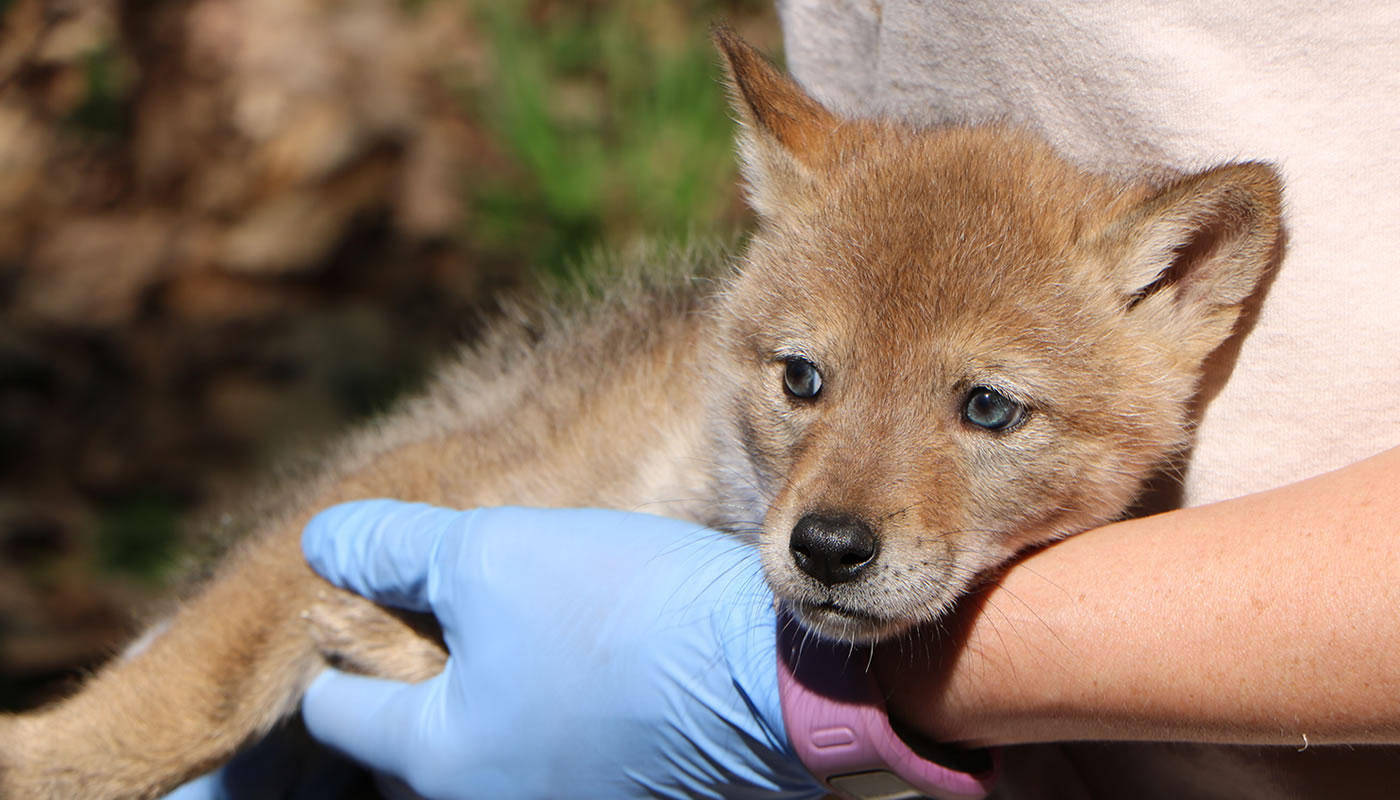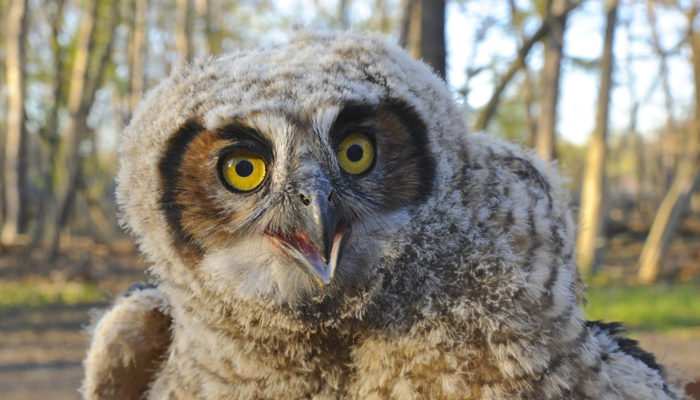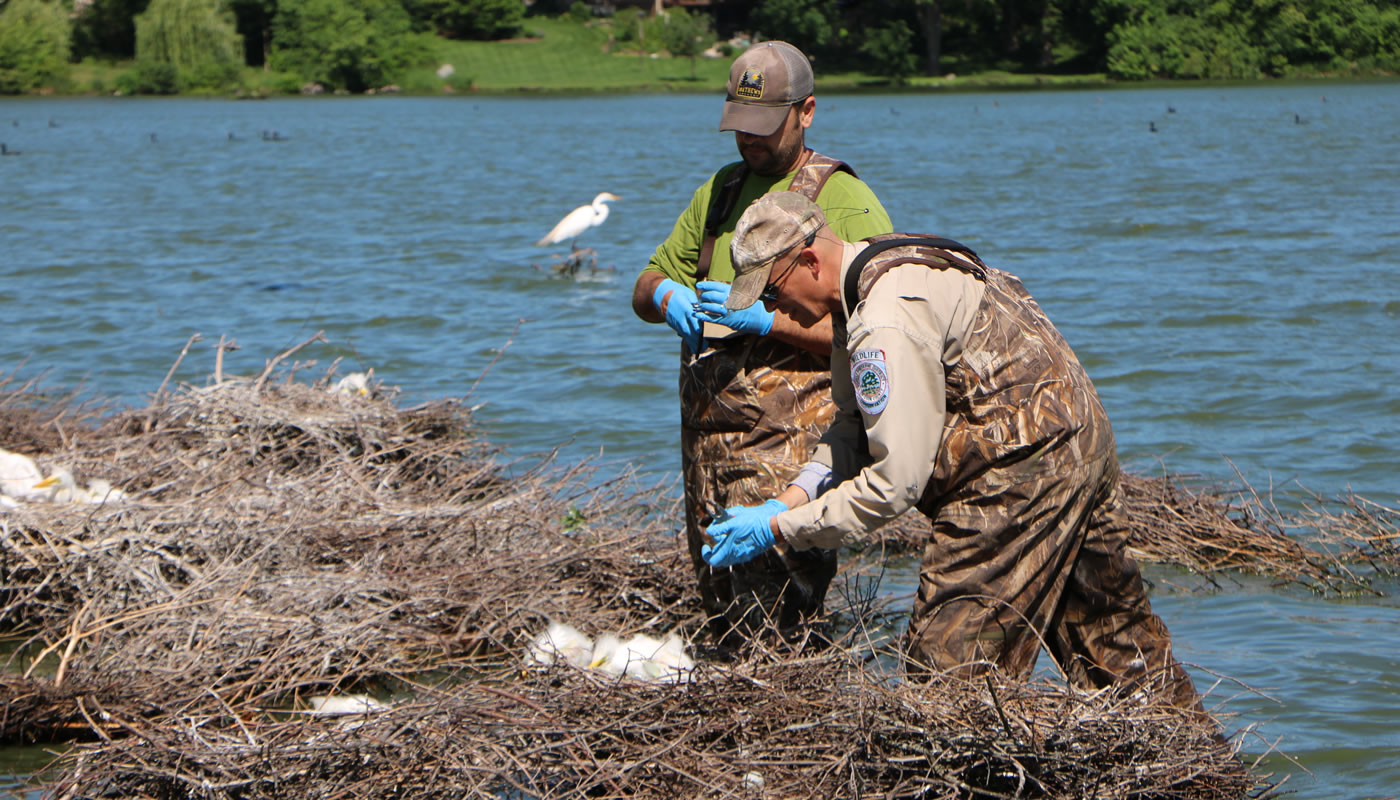The Forest Preserves of Cook County has long conducted field research and has well-established partnerships with academic research institutions. The Forest Preserves are home to some of the nation’s most biologically diverse flora and fauna, inspiring a wide array of scientists and students to better understand the natural world.
On this page:
- Research Agenda
- Urban Coyote Research Project
- Bird Banding & Research
- Research Ideas
- Research Access Permit
- Peer Reviewed Publications
Interactive Map Tells Story of Birds in Cook County & Beyond
From sparrows to sandhill cranes, Forest Preserves of Cook County biologists safely capture, handle and band an average of 400 birds per year. But what is bird banding and why do we do it?
Explore an interactive map, videos and photos that tell the story of our ongoing research to track zoonotic diseases (illnesses passed between animals and humans), uncover local environmental issues, and measure the success of our restoration efforts—all through the amazing birds that live in and migrate through Cook County.
Explore the Bird Banding StoryMap
Research Agenda
Each year The Forest Preserves’ Resource Management department issues more than 50 permits that allow researchers to conduct scientific studies on Forest Preserves land. Data from each project is shared with the Forest Preserves, allowing us to leverage resources and enrich our understanding of the natural world. Many researchers from throughout the country use Forest Preserves data to inform their work and guide land management, benefiting people, plants and animals.
The Forest Preserve engages in research to accomplish the following goals:
- Improve land management practices to maximize biodiversity.
- Understand the transmission of zoonotic diseases to protect public health, and enable additional research on the interaction between zoonotic diseases, flora and fauna.
- Expand understanding of climate change on local populations of plants and animals.
- Compile raw data to create usable and accessible databases, facilitating further analysis and study
The Forest Preserves works with a wide range of academic research partners from throughout the region and beyond, including:
- Chicago Botanic Garden
- Chicago Zoological Society/Brookfield Zoo
- Cornell University
- Field Museum
- Lincoln Park Zoo
- National Park Service
- Oregon State University
- Rutgers University
- The Ohio State University
- University of Wisconsin-Madison
- University of Illinois at Urbana-Champaign
- University of Tennessee
- University of Notre Dame
- University of Oklahoma
- University of California, Berkeley
The Forest Preserves also recruits citizen scientists who participate in long-running frog, bird, dragonfly, and plant monitor programs.
The Forest Preserves have done extensive research and data collection on zoonotic diseases, those diseases transmitted from animals to humans. The Forest Preserves’ has collected wildlife blood samples since 1988, making us one of the oldest and largest contributors to the Center for Disease Control. Our data collection was particularly useful during the first outbreaks of West Nile Virus and Lyme disease.

Urban Coyote Research Project
Urban Coyote Research Project is a partnership between the Forest Preserves, Cook County Animal & Rabies Control, Max McGraw Wildlife Foundation and The Ohio State University.
The Cook County Coyote Project is a comprehensive study of coyotes in Chicago metropolitan areas. Also known as the Urban Coyote Research Program, the study was initiated in 2000 as a non-biased attempt to address shortcomings in urban coyote ecology information and management; the Coyote Project is still underway. With the help of many key agencies, a continuous subset of coyotes is live-captured, collared, and released at their capture site. Coyotes are monitored to understand how they live in urban areas and how they interact with other wildlife, domestic animals, and humans.
Urban Coyote Research Project Website
In addition to giving researchers and the public a window into the lives of coyotes in Cook County, the project has provided training and support for multiple young researchers, including postdocs and graduate students.

Bird Banding & Research
From sparrows to sandhill cranes, Forest Preserves of Cook County biologists safely capture, handle and band an average of 400 birds per year. But what is bird banding and why do we do it?
Explore an interactive map, videos and photos that tell the story of our ongoing research to track zoonotic diseases (illnesses passed between animals and humans), uncover local environmental issues, and measure the success of our restoration efforts—all through the amazing birds that live in and migrate through Cook County.
Research Ideas
Looking for a research idea? Potential questions and topics:
- What are the most effective new chemical treatments of various invasive species?
- Does the full process of brush pile burning or chipping (trucks, chippers, etc.) produce more pollution?
- Is there a correlation between the incidence of prescribed burns and the occurrence of oak wilt disease?
- Is there an increase in insect diversity and plant interactions with prescribed burn practices?
- How do soil biotic elements affect ecosystem management outcomes and health?
- What are the biotic and edaphic factors that enhance a natural community’s resistance to invasive species?
- What is the impact of genetically modifying and mixing native plant communities?
Research Access Permit
Unless otherwise under contract with the Forest Preserves, all research investigations on Forest Preserve property require a Research Access Permit. Research investigations include any monitoring, collecting, testing, study, observation, investigation or other related activity, that benefit the Forest Preserves, public education or the community.
If these stipulations do not apply, or if the proposed activity includes the installation, repair or maintenance of roads, facilities, or structures, a Construction Access Permit will be required. The Research Permit has a maximum term of one year with five additional one year extensions as approved by the Forest Preserves.
- Research Access Permit (PDF)
- Special Access Permit Waiver- Entity (PDF)
- Special Access Permit Waiver- Individual (PDF)
Contact
Department of Resource Management
708-771-1180
ResourceManagement.FPCC@cookcountyil.gov
Peer Reviewed Publications
Bats
- Species-specific patterns of bat activity in an urban landscape. Gehrt, Stanley D. ; Chelsvig, James E. Ecological Applications 14(2)2004. p.625-635
- Bat activity in an urban landscape: Patterns at the landscape and microhabitat scale. Gehrt, Stanley D. ; Chelsvig, James E. Ecological Applications 13(4)2003. p.939-950
- Effects of recording media on echolocation data from broadband bat detectors. White, Ethan P.; Gehrt, Stanley D. . Wildlife Society Bulletin 29(3)2001. p.974-978
Cats
- Population Ecology of Free-Roaming Cats and Interference Competition by Coyotes in Urban Parks. Gehrt, Stanley D.; Wilson, Evan C.; Brown, Justin L.; Anchor, Chris (2013) PLoS ONE 8(9): e75718. doi:10.1371/journal.pone.0075718
Coyotes
- Serosurvey for Canine Influenza in Coyotes (Canis latrans) in Illinois, USA, 2000-23. Winter, J. M., Anchor, C., Gehrt, S. D., Landolfi, J., & Allender, M. C. (2024). Journal of wildlife diseases, 10.7589/JWD-D-23-00196.
- Is the urban coyote a misanthropic synanthrope? The case from Chicago Gehrt, Stanley D.; Brown, Justin L.; and Anchor, Chris (2011) “Is the Urban Coyote a Misanthropic Synanthrope? The Case from Chicago,” Cities and the Environment (CATE): Vol. 4: Iss. 1, Article 3.
- Home range and landscape use of coyotes in a metropolitan landscape: conflict or coexistence? Gehrt, Stanley D.; Anchor, Chris; White, Lynsey A. Journal of Mammalogy 90(5)2009. p.1045-1057
- Ecology of coyotes in urban landscapes. Gehrt, Stanley D Proceedings of the 12’~ Wildlife Damage Management Conference (D.L. Nolte, W.M. Arjo, D.H. Stalman, Eds). 2007
- Spatial and temporal variation in the diet of coyotes in the Chicago metropolitan area.
- Morey, Paul S.; Gese, Eric M.; Gehrt, Stanley. American Midland Naturalist 158(1)2007. p.147-161
Disease
- Environmental conditions for Jamestown Canyon virus correlated with population-level resource selection by white-tailed deer in a suburban landscape. Hollis-Etter KM, Montgomery RA, Etter DR, Anchor CL, Chelsvig JE, Warner RE, et al. (2019) PLoS ONE 14(10): e0223582.
- Pathologic Impacts of Contaminants in Freshwater Fish of Cook County IL. Imanse, Sierra M.; Anchor, Chris L.; Anchor, Gretchen C.; Landolfi, Jennifer A.; Kinsel, Michael J.; Levengood, Jeffrey M.; Delaney, Martha A.; Terio, Karen A. (2021) Aquatic Toxicology 106043.
- Importance of anthropogenic sources at shaping the antimicrobial resistance profile of a peri-urban mesocarnivore. Worsley-Tonks, Katherine E.L.; Miller, Elizabeth A.; Anchor, Chris L.; Bender, Jeff B.; Gehrt, Stanley D.; McKenzie, Shane C.; Singer, Randall S.; Johnson, Timothy J.; Craft, Meggan E. (2021) Science of The Total Environment 764: 144166.
- Characterization and Comparison of SLAM/CD150 in Free-Ranging Coyotes, Raccoons, and Skunks in Illinois for Elucidation of Canine Distemper Virus Disease. Burrell, C.E.; Anchor, C.; Ahmed, N.; Landolfi, J.; Jarosinski, K.W.; Terio, K.A. Pathogens 9(6)2020. 510.
- The Structure and Seasonality of Baylisascaris Procyonis Populations in Raccoons (Procyon Lotor) Page, L. Kristen; Delzell, Darcie A. P.; Gehrt, Stanley D.; Harrell, Elise D.; Hiben, Mark; Walter, Elizabeth; Anchor, Chris; Kazacos, Kevin R. Journal of Wildlife Diseases 52(2)2016. p.286-292
- Pathogen dynamics and morbidity of striped skunks in the absence of rabies. Gehrt, Stanley D.; Kinsel, Michael J.; Anchor, Chris. Journal of Wildlife Diseases 46(2)2010. p.335-347
- Backyard raccoon latrines and risk for Baylisascaris procyonis transmission to humans. Page, L. Kristen; Anchor, Chris; Luy, Ellen; Kron, Sarah; Larson, Grace; Madsen, Lauren; Kellner, Kenneth; Smyser, Timothy J. Emerging Infectious Diseases 15(9)2009. p.1530-1531
- The relationship between Baylisascaris procyonis prevalence and raccoon population structure. Page, L. Kristen; Gehrt, Stanley D. ; Cascione, Andrea; Kellner, Kenneth F. Journal of Parasitology 95(6)2009. p.1314-1320
- Columbid herpesvirus-1 in two Cooper’s Hawks (Accipiter cooperii) with fatal inclusion body disease. Pinkerton, Marie E.; Wellehan, James F. X., Jr.; Johnson, April J.; Childress, April L.; Fitzgerald, Scott D.; Kinsel, Michael J. . Journal of Wildlife Diseases 44(3)2008. p.622-628
- Land-use effects on prevalence of raccoon roundworm (Baylisascaris procyonis). Page, L. Kristen; Gehrt, Stanley D. ; Robinson, Nathaniel P. Journal of Wildlife Diseases 44(3)2008. p.594-599
- Lyme disease in urban areas, Chicago. Jobe, Dean A.; Nelson, Jeffrey A.; Adam, Michael D.; Martin, Stephen A., Jr. Emerging Infectious Diseases 13(11)2007. p.1799-1800
- Borrelia burgdorferi in Ixodes scapularis ticks, Chicago area. Jobe, Dean A.; Lovrich, Steven D.; Nelson, Jeffrey A.; Velat, Tom C.; Anchor, Chris; Koeune, Tad; Martin, Stephen A., Jr. Emerging Infectious Diseases 12(6)2006. p.1039-1041
- Measuring prevalence of raccoon roundworm (Baylisascaris procyonis): a comparison of common techniques. Page, L. Kristen; Gehrt, Stanley D. ; Robinson, Nathaniel P. Wildlife Society Bulletin 33(4)2005. p.1406-1412
- Seasonal survival and cause-specific mortality of urban and rural striped skunks in the absence of rabies. Gehrt, Stanley D. . Journal of Mammalogy 86(6)2005. p.1164-1170
- Effective primary isolation of wild-type Canine distemper virus in MDCK, MV1 Lu and Vero cells without nucleotide sequence changes within the entire haemagglutinin protein gene and in subgenomic sections of the fusion and phospho protein genes. Lednicky, John A.; Meehan, Thomas P.; Kinsel, Michael J.; Dubach, Jean ; Hungerford, Laura L.; Sarich, Nicolene A.; Witecki, Kelley E.; Braid, Michael D.; Pedrak, Casandra; Houde, Christiane M. Journal of Virological Methods 118(2)2004. p.147-157
- Raccoon roundworm encephalitis– Chicago, Illinois, and Los Angeles, California 2000. CDC – MMWR Weekly January 4, 2002/ 50(51);1153-5
- High prevalence of antibodies to Neospora caninum in white-tailed deer (Odocoileus virginianus). Dubey, J. P.; Hollis, K. ; Romand, S.; Thulliez, P.; Kwok, O. C. H.; Hungerford, L.; Anchor, C.; Etter, D. International Journal for Parasitology 29(10)1999. p.1709-1711
- Genotypic and phenotypic characterization of Borrelia burgdorferi isolated from ticks and small animals in Illinois. Picken, Roger N.; Cheng, Yu; Han, Dongmei; Nelson, Jeffrey A.; Reddy, A. Giridher; Hayden, Mary K.; Picken, Maria M.; Strle, Franc; Bouseman, John K.; Trenholme, Gordon M. Journal of Clinical Microbiology 33(9)1995. p.2304-2315
Raccoons
- Cytoarchitectural characteristics associated with cognitive flexibility in raccoons. Jacob, J., Kent, M., Benson-Amram, S., Herculano-Houzel, S., Raghanti, M. A., Ploppert, E., Drake, J., Hindi, B., Natale, N. R., Daniels, S., Fanelli, R., Miller, A., Landis, T., Gilbert, A., Johnson, S., Lai, A., Hyer, M., Rzucidlo, A., Anchor, C., Gehrt, S., & Lambert, K. Journal of Comparative Neurology 2021. p.1-14
- Behavioral and genetic aspects of the raccoon mating system. Hauver, Stephanie A.; Gehrt, Stanley D. ; Prange, Suzanne; Dubach, Jean. Journal of Mammalogy 91(3)2010. p.749-757
- Maternal response to conspecific visits at natal dens in raccoons (Procyon lotor). Hauver, Stephanie A.; Gehrt, Stanley D. ; Prange, Suzanne. American Midland Naturalist 163(2)2010. p.374-387
- The influence of anthropogenic resources on multi-scale habitat selection by raccoons. Bozek, Clare K.; Prange, Suzanne; Gehrt, Stanley D. . Urban Ecosystems 10(4)2007. p.413-425
- Influences of anthropogenic resources on raccoon (Procyon lotor) movements and spatial distribution. Prange, Suzanne; Gehrt, Stanley D. ; Wiggers, Ernie P. Journal of Mammalogy 85(3)2004. p.483-490
- Demographic factors contributing to high raccoon densities in urban landscapes. Prange, Suzanne; Gehrt, Stanley D. ; Wiggers, Ernie P. Journal of Wildlife Management 67(2)2003. p.324-333
- Drug effects on recaptures of raccoons. Gehrt, Stanley D. ; Hungerford, Laura L.; Hatten, Suzanne. Wildlife Society Bulletin 29(3)2001. p.833-837
White-tailed Deer
- Environmental conditions for Jamestown Canyon virus correlated with population-level resource selection by white-tailed deer in a suburban landscape. Hollis-Etter KM; Montgomery RA; Etter DR; Anchor CL; Chelsvig JE; Warner RE; et al. (2019) PLoS ONE 14(10): e0223582. https://doi.org/10.1371/journal.pone.0223582
- Behavior and survival of white-tailed deer neonates in two suburban forest preserves. Piccolo, B. P.; Van Deelen, T. R.; Hollis-Etter, K.; Etter, D. R.; Warner, R. E.; Anchor, C. Canadian Journal of Zoology 88(5)2010. p.487-495
- Survival and movements of white-tailed deer in suburban Chicago, Illinois. Etter, Dwayne R.; Hollis, Karmen M.; Van Deelen, Timothy R.; Ludwig, Daniel R.; Chelsvig, James E.; Anchor, Chris L.; Warner, Richard E. Journal of Wildlife Management 66(2)2002. p.500-510
- Sex affects age determination and wear of molariform teeth in white-tailed deer. Van Deelen, Timothy R.; Hollis, Karmen M.; Anchor, Chris; Etter, Dwayne R. Journal of Wildlife Management 64(4)2000. p.1076-1083
- Overabundant deer: Better management through research. Etter, Dwayne R. Van Deelen, T. R.; Ludwig, Daniel R.; Hollis, Karmen M.; Warner, R. E.; Chelsvig, James E. Wildlife Damage Management Conference Proceedings Year 2000
- Radio-telemetry and geographical information systems to assess urban deer zoonoses. Karmen M.; Anchor, Chris L.; Chelsvig, James E.; Etter, Dwayne R.; Dubey, J. P.; Warner, R. E.; Hungerford, Laura L. Wildlife Damage Management Conference Proceedings Year 2000
- Variation of white-tailed deer home ranges in fragmented urban habitats around Chicago, Illinois (2000). Piccolo, B. P.; Van Deelen, T. R.; Hollis, K.; Etter, D. R.; Warner, R. E.; Anchor, C. Wildlife Damage Management Conference Proceedings Year 2000
Books
- Coyotes Among Us: Secrets of the City’s Top Predator. Stanley D. Gehrt, Kerry Luft, ed. 2024. Seattle, Washington, USA: Flashpoint.
- Urban Carnivores: Ecology, Conflict, and Conservation. Stanley D. Gehrt, Seth P.D. Riley, Brian L. Cypher, ed. 2010. Baltimore, Maryland, USA: Johns Hopkins University Press.
- Flora of the Chicago Region: A Floristic and Ecological Synthesis. Gerould Wilhelm, Laura Rericha, ed. 2017. Indianapolis, Indiana, USA: Indiana Academy of Science.
- Rothrock, P. E. (2021). Sedges of Indiana and the Adjacent States: The Carex Species (Vol. II). Indiana Academy of Science.
Other
- An Ad Hoc Assessment of Blanding’s Turtle Translocation Success. King, R., Anchor, C., Jablonski, C., Jaeger, C., Ludwig, D., Roloff, A., & Thompson, D. Herpetological Review 54(3)2023. p.362-364
- A Certain Type of Place. Dosmann, Michael S.; Thomas, E. Arnoldia 80(1)2023. p.8-10
- A diagnostic key to ants ecologically affiliated with the genus Carex. Rericha-Anchor, L. Proceedings of the Indiana Academy of Science 130(2)2022. p.130-137
- Seed sourcing strategies for ecological restoration under climate change: A review of the current literature. Vitt P, Finch J, Barak RS, Braum A, Frischie S and Redlinski I (2022) Front. Conserv. Sci. 3:938110. doi: 10.3389/fcosc.2022.938110
- Movement of Hypophthalmichthys DNA in the Illinois River Watershed by the Double-Crested Cormorant (Phalacrocorax auritus) Guilfoyle, Michael P.; Farrington, Heather L.; Lance, Richard F.; Hanson-Dorr, Katie C.; Dorr, Brian S.; Fischer, Richard A. Waterbirds 40(1)2017. p.63-68
- Linking Grassland and Early Successional Bird Territory Density to Predator Activity in Urban Parks Thieme, Jennifer L.; Rodewald, Amanda D.; Brown, Justin; Anchor, Chris; Gehrt, Stanley D. Natural Areas Journal 35(4)2015. p.515-532
- Response of skunks to a simulated increase in coyote activity. Prange, Suzanne; Gehrt, Stanley D. Journal of Mammalogy 88(4)2007. p.1040-1049
- Interference competition between coyotes and raccoons: a test of the mesopredator release hypothesis. Gehrt, Stanley D.; Prange, Suzanne. Behavioral Ecology 18(1)2007. p.204-214
- New radiocollars for the detection of proximity among individuals. Prange, Suzanne; Jordan, Trevor; Hunter, Colin; Gehrt, Stanley D. Wildlife Society Bulletin 34(5)2006. p.1333-1344
- Changes in mesopredator-community structure in response to urbanization. Prange, Suzanne; Gehrt, Stanley D. Canadian Journal of Zoology 82(11)2004. p.1804-1817
- Raccoons, coyotes, and reflections on the mesopredator release hypothesis. Gehrt, Stanley D. ; Clark, William R. Wildlife Society Bulletin 31(3)2003. p.836-842
- Scale effects between body size and limb design in quadrupedal mammals. Kilbourne BM, Hoffman LC (2013) PLoS ONE 8(11): e78392. doi:10.1371/journal.pone.0078392

